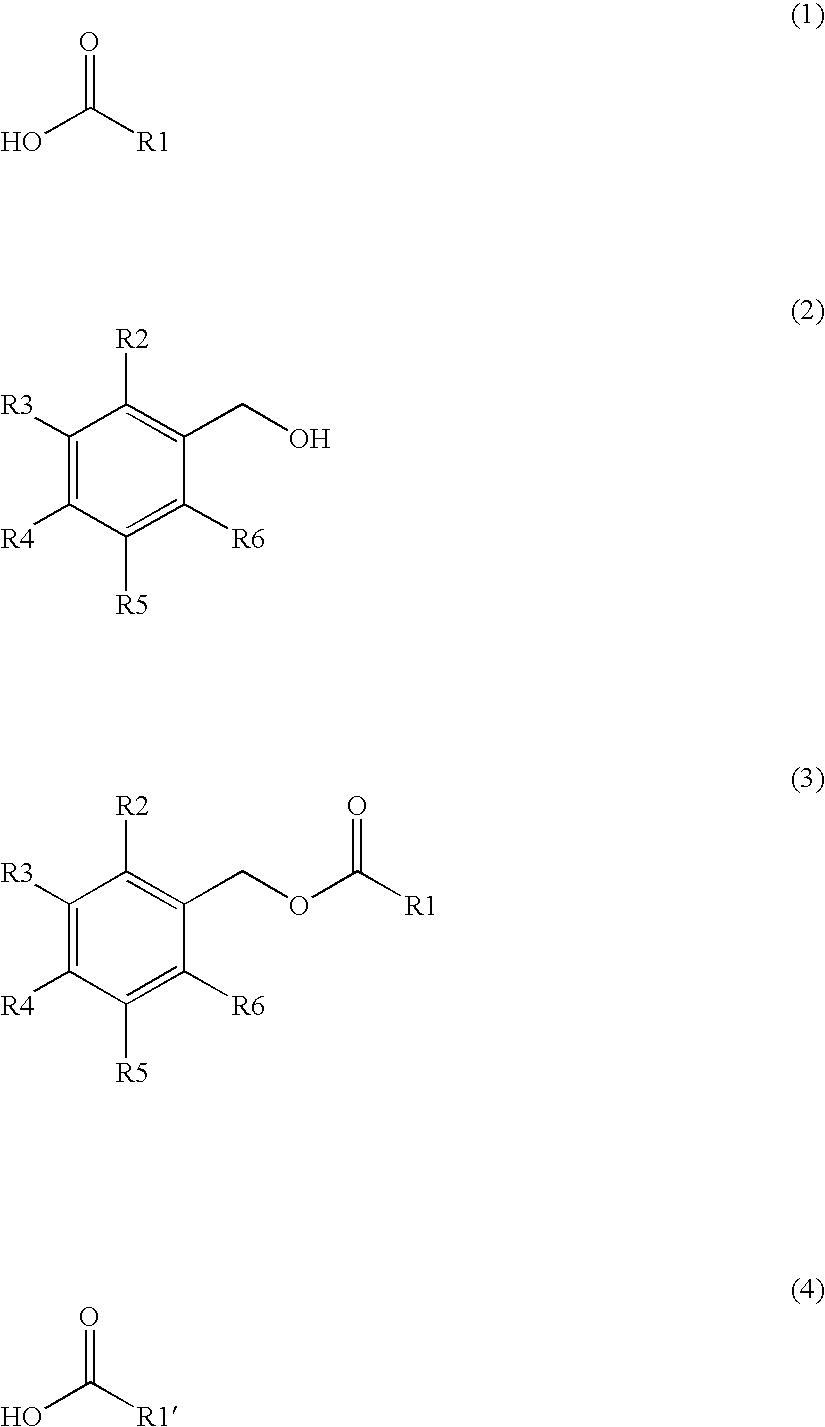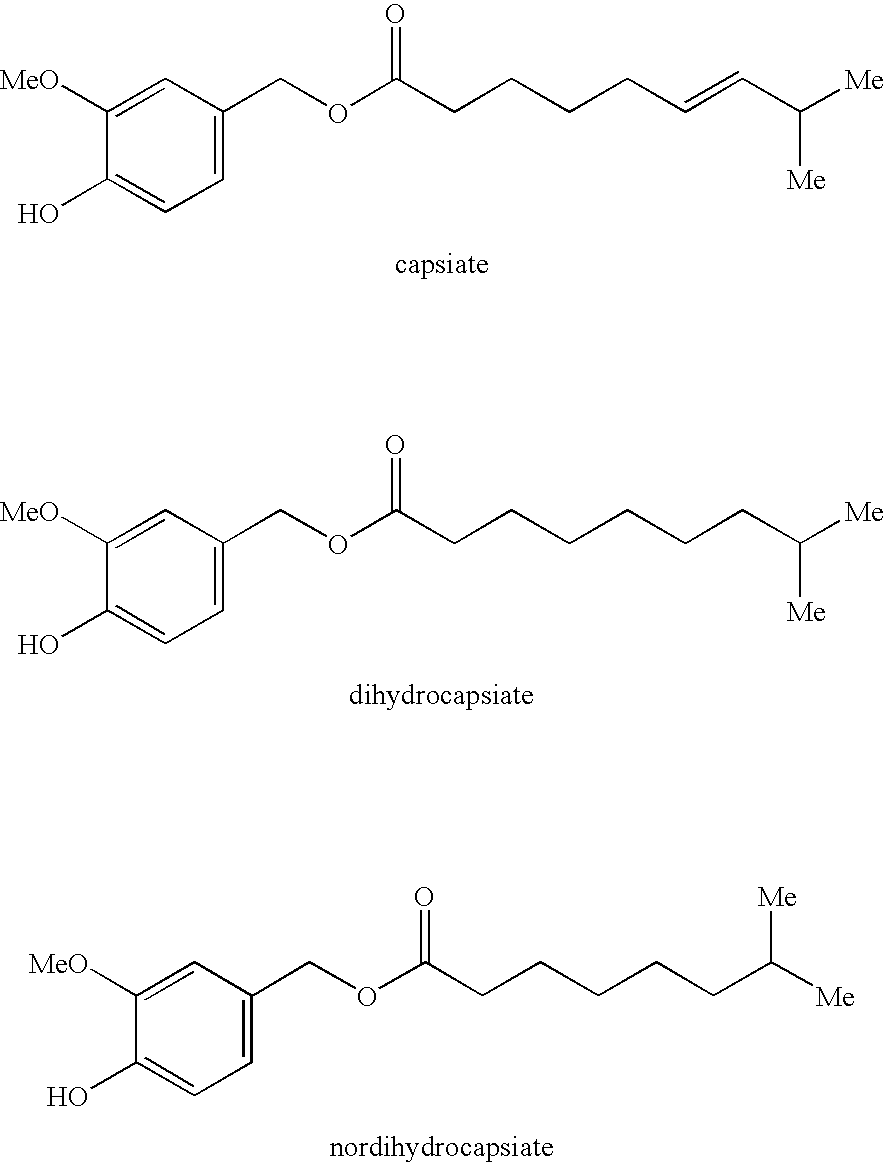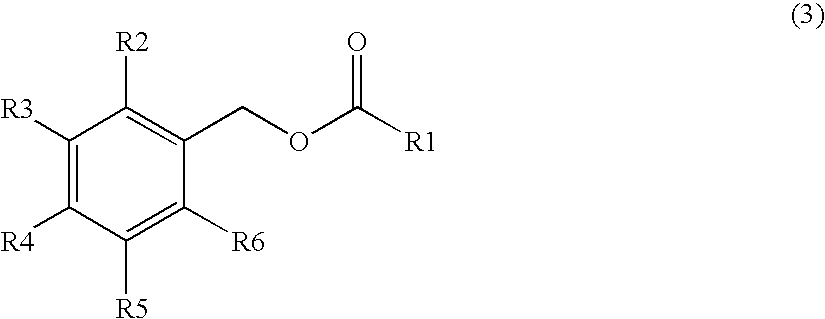Production method of capsinoid by dehydrating condensation, stabilizing method of capsinoid, and capsinoid composition
a production method and technology of capsinoid, which are applied in the field of production methods of capsinoid by dehydrating condensation, stabilizing methods of capsinoid, and capsinoid composition, can solve the problems of limited production of capsinoids with high purity in a large amount from natural sources, and the inability to use capsaicin in a limited amount, etc., and achieves short time using an enzyme, convenient production, and high yield
- Summary
- Abstract
- Description
- Claims
- Application Information
AI Technical Summary
Benefits of technology
Problems solved by technology
Method used
Image
Examples
example 1
Synthesis of 8-methylnonanoic Acid (Example of Cross Coupling Method)
[0175] Under an argon atmosphere, Mg turnings (6.12 g, 252 mmol) were suspended in THF (10 ml). 200 mg from isopentyl bromide (34.6 g, 229 mmol) was added at room temperature, and exothermic heat and foaming were confirmed. THF (50 ml) was added, and a solution of the entire remainder of the isopentyl bromide in THF (65 ml) was slowly added dropwise at room temperature over 1 hour, and the mixture was stirred for 2 hours. At this time, mild refluxing state was achieved. The reaction solution was filtered through cotton plug while washing with THF to give a solution (total amount 180 ml) of isopentylmagnesium bromide in THF.
[0176] Under an argon atmosphere, copper (I) chloride (426 mg, 4.30 mmol) was dissolved in NMP (55.2 ml, 575 mmol). The reaction vessel was cooled to 0° C. (ice bath), and a solution of ethyl 5-bromovalerate (30.0 g, 144 mmol) in THF (35 ml) was added dropwise over 10 minutes. The THF solution ...
example 2
Purification of 8-methylnonanoic Acid by Formation of Cyclohexylamine Salt Thereof (Example of Purification by Fatty Acid Salt Crystal)
[0182] From the 8-methylnonanoic acid crude product obtained in Example 1, 8.00 g was dissolved in heptane (30 ml). Cyclohexylamine (6.91 ml, 60.4 mmol) was slowly added dropwise at 0° C. (ice bath), and the mixture was stirred at room temperature for 20 minutes. The reaction mixture was filtered to give 8-methylnonanoic acid cyclohexylamine salt (15.7 g).
[0183]1H-NMR(CDCl3, δ): 0.81-0.85 (m, 6H), 1.11-1.20 (m, 3H), 1.24-1.35 (m, 10H), 1.46-1.68 (m, 4H), 1.73-1.81 (m, 2H), 1.96-2.02 (m, 2H), 2.15-2.19 (t, 2H), 2.77-2.88 (m, 1H).
[0184] melting point: 70.1 to 70.6° C.
[0185] 10% Aqueous citric acid solution (50 ml) and heptane (50 ml) were added to the salt (15.6 g therefrom) to allow partitioning. The aqueous layer was extracted with heptane (50 ml), and the combined heptane layer was washed with 10% aqueous citric acid solution (50 ml), water (50 ...
example 3
Resolution of Trans Form and Cis Form of 8-methyl-6-nonenoic Acid by cis-2-aminocyclohexanol Salt Thereof (Example of Purification Method by Formation of Fatty Acid Salt Crystal)
[0187] 8-Methyl-6-nonenoic acid (isomer ratio trans:cis=88:12, 800 mg, 4.70 mmol) obtained by a known method (J. Org. Chem., 1989, 54, 3477-3478) was dissolved in chloroform (10 ml), and a solution of cis-2-aminocyclohexanol (460 mg, 4.00 mmol) in chloroform (5 ml) was added dropwise at room temperature. The reaction mixture was concentrated under reduced pressure, the residue was again dissolved in chloroform (4 ml), and hexane (12 ml) was added dropwise. The reaction mixture was stirred at room temperature for 3 days, and the precipitated crystals were collected by filtration. Hexane (10 ml) was added to the obtained crystals, and the mixture was washed three times with 10% aqueous citric acid solution (8 ml) and once with saturated brine (10 ml), and dried over anhydrous magnesium sulfate. Magnesium sulf...
PUM
| Property | Measurement | Unit |
|---|---|---|
| temperature | aaaaa | aaaaa |
| temperature | aaaaa | aaaaa |
| temperature | aaaaa | aaaaa |
Abstract
Description
Claims
Application Information
 Login to View More
Login to View More - R&D
- Intellectual Property
- Life Sciences
- Materials
- Tech Scout
- Unparalleled Data Quality
- Higher Quality Content
- 60% Fewer Hallucinations
Browse by: Latest US Patents, China's latest patents, Technical Efficacy Thesaurus, Application Domain, Technology Topic, Popular Technical Reports.
© 2025 PatSnap. All rights reserved.Legal|Privacy policy|Modern Slavery Act Transparency Statement|Sitemap|About US| Contact US: help@patsnap.com



